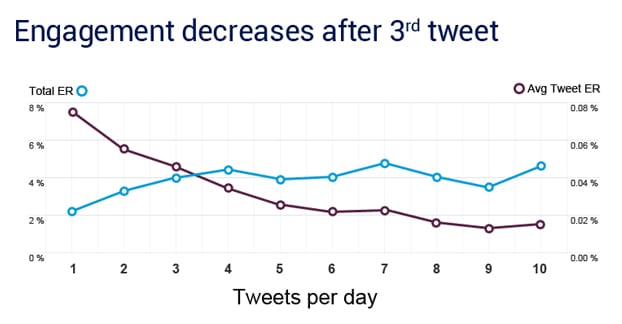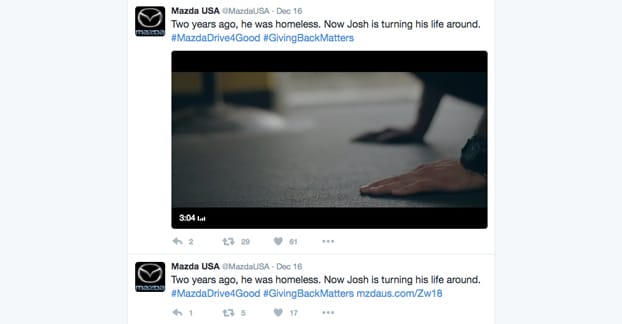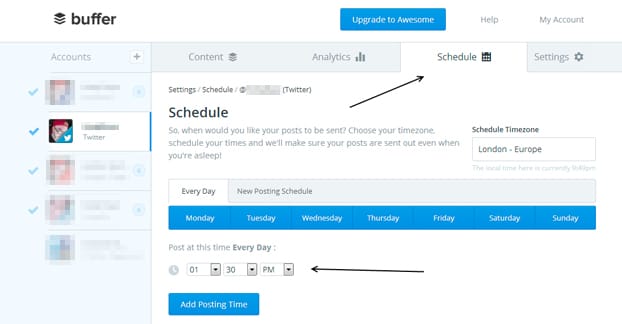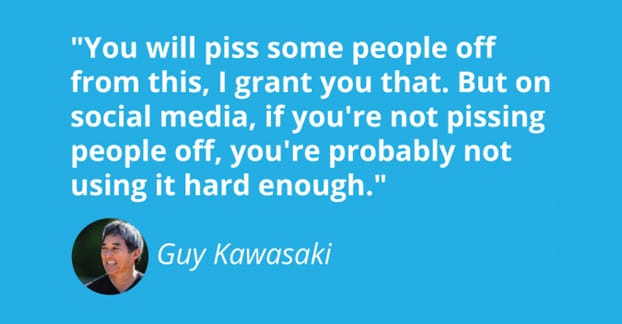One of the most interesting things about Twitter is the fact that, unlike other social networks, you have to go against your gut feelings. Twitter is a very time-sensitive platform, which means messages have a very short lifespan. If one of your followers hasn’t seen a tweet within an hour or two, chances are they probably won’t see it at all.
Oh, Twitter has a curated feed, but that almost makes it worse. It means that some people will get preferential treatment, and others will rarely be seen at all. It’s not quite as bad as Facebook, since the time-focused feed is below the curated feed, but it still means a lot of your users won’t see your messages up front and center the way you would like. You end up with a buffer of other peoples’ content in front of yours, in addition to all of the content posted since you posted.
For some people, particularly your most engaged users, it will work out in your favor. They will see your content ahead of all the rest, every time they log in. For most of your followers, though, it’s a net loss.
This is where you have to go against your instincts. On social networks, on forums, on blog comments, and on blog posts themselves, the general thinking is to post once and once only. There are good reasons for this, of course. For social networks, people are worried about spam. When your users see too many messages from you in their feed in too short a time, they’ll be more likely to think you’re spamming them. This can result in an unfollow or even a spam report, which can be very detrimental.
In forms of permanent content, like forum posts, blog posts, and comments, duplicate comments or content can be very detrimental. There, not only do you not have “the algorithm” to blame for users seeing your content more frequently than you would like, the evidence is plain to see. You’re not suspected of spamming, you actually are spamming. Not to mention, duplicate content penalties for SEO can be extremely bad.
On Twitter, though, most people aren’t browsing your profile page itself, they’re browsing their own feeds. This means even if you post the same exact tweet once every six hours, they aren’t likely to see it more than once or twice. Even if they do see it more often, they might attribute one instance to the curated feed and one to the timeline feed, and won’t think twice about it.
A Layer of Deviousness
Here’s the thing, though; you aren’t necessarily ever going to be posting the same exact tweet more than once. The content of the tweet will be the same, but the actual tweet will be different, if you know what I mean.
Say, for example, you’re a car company, like Mazda. You’re releasing new models for the new model year, of your two primary makes, the Mazda 3 and the Mazda 6. You can easily post once per day, alternating, for each of the cars. So you might have a Mazda 3 post on Monday, a 6 post on Tuesday, another 3 post on Wednesday, and so forth.
In fact, Mazda does exactly that. You can check their Twitter feed right now and likely see an example of this in action, though obviously if you’re coming into this article months after it was published, it will look a little different.
Each individual tweet is unique. One might call out the interior styling of the car, while the next talks about the engineering of the gas pedal, and the next talks about how tight the steering is, and another is just a promotional video looking to exhibit an emotion in the viewer.
Every brand can do this, and in fact, I highly recommend doing it. You might not be pitching a series of new car models, but you’re probably promoting a week’s worth of blog posts.
An Example
For this thought experiment – I don’t have a Twitter account on hand to show you it in practice – let’s assume you’re a blog writing an average of three blog posts per week. One is published on Monday, one on Wednesday, and one on Friday.
Let’s say you also try to maintain an active Twitter account. Now, I’ve talked about it before, but an ideal Twitter account tends to post around 3-5 times per day. We’ll say you’re going for the middle of the road, four times a day.
You have, in a given week, three pieces of content to promote and 20 individual tweets with which to do it. Some of those tweets will be content other than your own, and some of them will be non-promotional comments and just plain old organic posts. Let’s say that takes up 5 of your posting slots, leaving you 15 left.
15 tweets over the course of five days, which is a nice even three per day. Your tweets are going to be spread throughout the day, so readers are rarely going to see all of them, but you’ll be catching most of your active audience throughout the day.
A schedule for posting, then, might look something like this.
- Monday: Publish blog post 1, tweet about post 1, tweet about organic item, tweet about a post from last week, tweet about post 1 again.
- Tuesday: Tweet about blog post 1, curate a piece of content, tweet about a post from last week, tweet about post 1 again.
- Wednesday: Publish blog post 2, tweet about post 2, tweet about post 1, curate a piece of content, tweet about post 2 again.
- Thursday: Tweet about post 2, post something organic, tweet about post 1, tweet about post 2.
- Friday: Publish blog post 3, tweet about post 3, tweet about post 2, post something organic, tweet about post 3 again.
This continues from week to week. The “post from last week” slots will be the previous week’s post 3 or post 2, whichever you want to push more.
Obviously, this becomes a very self-promotional feed. It’s always possible to adjust it, though. If you find that people don’t like so many posts promoting your blog, you can dial back a little bit and cut out some of the promotion of post 1 on Thursday and Friday.
How can you post tweets about the same piece of content over and over? It’s actually pretty easy, if you take a look at many of the blogs out there that use a click to tweet plugin.
Ideas for Tweeting Multiple Times
What I’ve done here is come up with a bunch of ideas you can use to tweet a post. Any one of them will make a good single tweet, and they are all unique so you can use them to tweet the same content in an interesting way. Don’t forget to include the link and any relevant hashtags you might want to use!
- Simply post the title of the blog post as a new tweet with a link to that post.
- Post an interesting question that is answered by the post.
- Ask the reader if they’ve ever encountered X problem that your post solves.
- Post an interesting piece of data or a statistic that you bring up as part of the source information for your post.
- Send an @mention to an influencer you mention or link to in your post, but use the mention later in the tweet so it’s a public tweet.
- Send a similar version of the previous options, but with different images attached to the tweet to make it look different in your stream.
- Repeat the same exact tweet at a very different time of day to reach a different segment of your audience.
Don’t be too afraid of repeating posts too often. Hootsuite posted one particular link 44 times, and considered it perfectly fine. They even got called out for it, but the fact is, they have so many followers that it’s still relatively unique each time it’s posted.
That’s one of the major tricks you need to remember; the larger your audience, the more you can get away with. The larger your audience, the more raw numbers see your posts, but the lower the overall percentage is. This is simply due to how distributed across time zones and activity hours your audience becomes. When you have 5,000 followers, you might not even be able to support 20 tweets per week. When you have 5,000,000 followers, you can post pretty much as often as you want and people will emulate you in hopes of gaining your level of success.
After all, all an influencer is is someone who happens to be successful. It doesn’t really matter if you completely lucked into your fame; people will try to figure out how to emulate what you did so they too can luck into fame. Once you reach the level of influencer, you’re no longer beholden to the treads, you become the one setting those trends. A trendsetter, if you will.
At the end of the day, that’s what we all aspire to be. When you reach that level of fame, you don’t need to pay so much attention to the fine details of marketing, and can instead focus on the broad strokes.
Words of Caution
Before you embark upon a course of multi-posting your content, you should be aware of the possible pitfalls in doing so.
Number one is the size of your audience. If your audience is too small, it won’t be able to support such frequent posting. People will wonder why you’re acting like a huge brand when you’re not, and you’ll get a bit of a negative reputation just based on acting like an imposter. The “dress for the job you want” ethos doesn’t quite work here.
Second is that you should avoid posting the exact same tweet more than 2-3 times in a given week. You can post the same link multiple times, the same tweet with different images, and so forth, but you can’t post the exact same tweet with the exact same link, hashtags, and images over and over. This begins to look a lot more like spam and might force Twitter to take action. It will also likely result in some unfollows when people decide they don’t want to see the same thing over and over.
Be mindful of user complaints about your content. If people come forward to reply to your messages or DM you about how they don’t like seeing your content that often, it’s something worth analyzing. Remember that for every person who comes forward, there are anywhere from a dozen to a thousand more who have the same opinion but who don’t care enough to speak up.
Always be experimenting. If your audience seems responsive to X number of tweets of a given piece of content, try to tweet the next one X+1 times. However, you have to be mindful of the difference in content itself. One piece might do well, not because of how often you tweet it, but because it’s simply a better, more resonant article.
Obviously, you should experiment with different kinds of tweets. Does your audience respond more to statistics or questions? Do they like tweets with serious images or memes? Do they prefer jokes or serious tones in their hashtags? These are all questions you can answer and use to adapt the future posts you create and market.
At the end of the day, you always have to be adaptable. No one strategy is going to fit every brand, and in fact, no one strategy is going to fit your brand for more than a year. The social world is always changing, and the techniques you use to reach your audience today might not work tomorrow.









Thanks for these tips! I hate to feel like I’m spamming people via Twitter but I actually have some information that I think people will want to see. You’ve armed me with some tactful ways to share it! Thanks.
Yes, thank you. For about two weeks, I have been circling around this issue, but unable to get it clear. You have done so. The problem is Twitter is exactly the opposite of email. When I send a mail, I assume the other person will see it. With Twitter, the opposite assumption is correct, and this takes some getting used to. If I want them to definitely see it, I must DM.
Many thanks for this, it makes sense and confirms what I was thinking about how Twitter would handy similar Tweets.
Cheers Dave, glad you found it useful 🙂